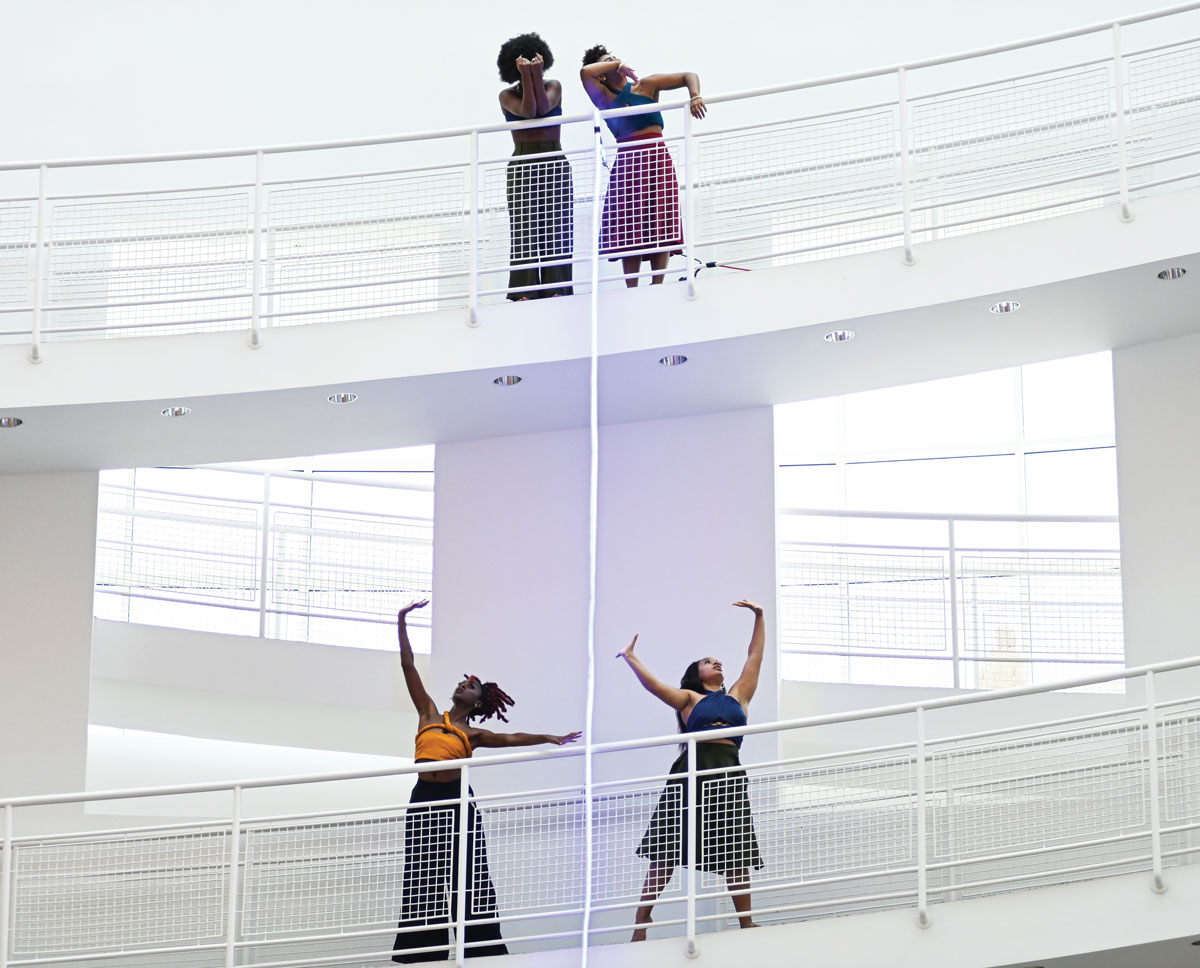
Photograph by Melissa Alexander
When artist and scholar Fahamu Pecou traveled to Panama for the first time, he was convinced—I kid you not, he insists—that the food he ate there was just like the meals that his grandma in South Carolina used to prepare. His first sojourn to South Africa yielded a similar revelation. There, he heard singing in the same rhythms and chords of the churches that he attended in his childhood. Earlier this year in Kinshasa, the capital of the Democratic Republic of the Congo, he saw a city built for only 500,000 that was vibrant and teeming with a population of 15 million—and it made him think of home, in ever-expanding Atlanta. “I kept seeing pieces of myself,” he says. “That journey throughout the African diaspora has allowed me to reassemble and have a deeper understanding of who I am because of my relationship to these places that I didn’t know that I had.”
Pecou funneled what has been a lifelong quest to artistically suture these experiences together into an innovative concept: a virtual museum that highlights the global Black experience. The African Diaspora Art Museum of Atlanta’s north star is exploring and advancing conversations around contemporary Black art and culture through exhibitions, programs, and artist residencies. Pecou says launching ADAMA virtually has allowed it to quickly emerge not just as a localized idea but as a diasporic space that has already engaged communities around the world—making Atlanta a site, like Panama, South Africa, Kinshasa, churches, and his grandma’s kitchen, “that is reflective and indicative of the African diaspora in its totality.”

Photograph by Natrice Miller
What kind of artist wakes up and says, I want to launch a museum?
I don’t think that it’s a strange or unheard-of thing for an artist to imagine a space where they would feel reflected. That is the emphasis behind this idea of creating a space that is reflective of my community’s interests and aspirations, and, ultimately, one that provides an image or a reflection that is affirming. I think a lot of artists struggle with that, particularly artists of color. We continue to have these conversations about the challenges that Black people, in particular, are having in mainstream art spaces, whether they are artists, curators, or just visitors. The idea that these spaces have to make special accommodations to include us in the year 2021 is problematic. I think about all the young children in the city who either have hopes or dreams about becoming artists but don’t necessarily know how to go about doing that and have not necessarily seen themselves in these spaces. That’s what ADAMA is about.
Throughout time there have been various containers for art and culture. Why did you choose the museum medium?
I was thinking that the language that we use around museums is very specific and oftentimes very limiting. We have to reimagine how museums actually contribute to our notion of community. A museum for art is, in essence, what a library is for our intellectual spaces, what a church is for our spiritual spaces. If we think of a museum as sort of a library of how we see ourselves and how we interact with ourselves, I think that changes the way we then value what museums bring and provide for us. In most contexts, the museum is about othering and creating separations. It’s like, Look at this thing that we got from this place. Look at how strange and foreign this is to us. Our goal with ADAMA is not about putting up borders but, rather, tearing them down. It’s showing how we are alike and how we are connected, which is why our motto is “Everywhere we go, there we are.” Rather than be a place where you just go because you want to look at something on a wall, we call exhibitions experiences. African-descended people are intimately familiar with the notion of call and response, so, how do you create exhibitions that reflect that, where the audience is a part of the experience? These are the kinds of questions that we’re asking ourselves.
Talk a little bit about your programming—what you’ve done so far and what you hope to do.
One of our first programs was the ADAMA Art Salon, which we launched last year and is now in its fourth season. This is a series that we do on Sundays at noon, where we have conversations with artists, prominent collectors, and directors of institutions that center African diasporic art. There’s also a series we call Midnight Oil where we ask practicing artists across disciplines to put together a playlist of the music that they’re listening to when they’re doing whatever it is that they do in their studios. Another program, Permanent, is a collaboration between ADAMA, Komansé Dance Theater, and the High Museum. We do interdisciplinary interpretations of works by Black artists in the museum’s permanent collections in an attempt to mitigate the divide that exists between the Black community and conventional presentations of art in museums and institutions. For example, you walk into a museum, and there’s a work by Richard Mayhew, an abstract expressionist painter. With Permanent, we study what the artist was intending to convey through that work and then reinterpret that through dance and music. We create a visual experience and live performance around it that allows for the viewer to now go back to that museum and see that painting in a whole new way and have a whole new relationship with it. Through these interpretations, we’re able to challenge what people think about when they look at work by Black artists in these spaces.
You launched ADAMA virtually, but do you have plans for a physical space?
We have been in conversation with a number of developers in the city who are working on new projects and are very interested in what we’re doing. It looks very likely that we’ll end up being the anchor to one of these developments. We are wholly committed to building ADAMA in a community that has been traditionally underserved by the arts, and by that, I mean in a Black neighborhood. There are a number of opportunities on the table, nothing solid just yet. In the meantime, maybe one day soon, we’ll be able to do something like FESTAC ’77, the African Festival of Arts and Culture. It was a huge deal that brought the African diaspora together in Lagos, Nigeria, for the first time around arts and culture. Ed Spriggs, who was the director of the Hammonds House Museum, was an active participant; so were members of the Atlanta University Center. I think there’s so much potential for what ADAMA can do, not just for Atlanta but for this global conversation around contemporary Black art and culture. To be able to do it from a city like this, with its international profile and resources—it’s a no-brainer. This is about putting a flag in the ground and saying Black culture in Atlanta lives here at ADAMA. And you don’t have to wait every other summer for an event to experience it. You don’t need a festival to experience it. You can come get this culture 365 days of the year.
This article appears in our November 2021 issue.











![The North Carolina Museum of Natural Sciences’ newest exhibit is a [pre]historic first](https://cdn2.atlantamagazine.com/wp-content/uploads/sites/4/2024/04/DD-3-100x70.jpg)


